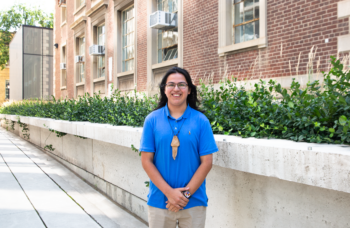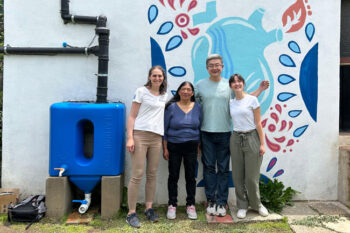Earlier this month, U of T Engineering welcomed its two newest faculty members. They join a dynamic community, producing world-leading research in their areas of expertise while inspiring and nurturing the next generation of global engineering leaders.
Professor Mason Ghafghazi (CivE) completed his PhD in geotechnical engineering at the University of British Columbia in 2011. After a term at BC Hydro, he attended the University of California Davis to do postdoctoral research on liquefaction susceptible dams in California. He specializes in liquefaction assessment, field investigation and constitutive modelling of soils.
Professor Masayuki Yano (UTIAS) completed his PhD in Aeronautics and Astronautics from Massachusetts Institute of Technology (MIT) in 2012 and did postdoctoral work in the group of Professor Anthony Patera in the Department of Mechanical Engineering at MIT. His research focuses on building mathematical models that support the design of new aeronautical components, from airplane landing gear to rocket engines.
U of T Engineering spoke with the new professors to find out more about their research and what they’re looking forward to at U of T:
Could you explain the focus of your research?
MG: Everything on earth is sitting on either rock or soil. Soils can also be building materials for much of our infrastructure — embankment dams are one example. I come from the West Coast, and one of my main focuses is what happens to soils during earthquakes. Some soils liquefy, meaning that in a matter of seconds they transform from a strong material holding bridges and buildings to a soup that buildings and cars can sink into.
Students in my group use laboratory testing and numerical modelling to figure out what soils, under what types of earthquake loading, will liquefy and how much damage they will cause.
One thing that makes soils particularly interesting as engineering materials is that unlike steel, concrete, or carbon fibre, we do not get to choose them. We have to deal with whatever is in the ground where a project happens to be. So part of my work is building, analyzing, and improving tools that we use in the field to characterize soils. This work also involves lab testing and computational modelling. In addition to that, we build new tools and modify existing ones to measure things that were unknown before.
MY: My research focuses on the development of computational methods for problems in aerospace sciences and engineering. Specifically, I develop computational algorithms to accurately and efficiently solve partial differential equations with applications in aerodynamics and continuum mechanics. The goal is to develop computational tools that facilitate the analysis and design of the next generation of aerospace vehicles.
Why did you choose U of T?
MG: U of T has many attributes, including world recognition, being in a large vibrant city and having many world-class facilities that make it attractive to any young academic. What made it particularly attractive to me was a sense of collegiality and support for research that is probably unparalleled in Canada and many other places in the world, too. This includes multiple research funding sources, scholarships for students and most importantly, opportunities for collaboration.
Toronto is a great city to live in. It seems like other people like it as much as I do, and that means that there are lots of room to work with various engineering firms in the city to address their research needs. It also means that there are many smart hard working students coming through our own undergraduate program or other programs in the area who can help create a successful and productive research group.
MY: U of T provides strong research programs that attract outstanding students from around the world. Faculty members are leaders of their respective research fields and they also take their teaching responsibilities seriously. This excellence in both research and teaching is what attracted me to U of T.
What are you most looking forward to in your new position?
MG: We are expanding our geotechnical testing laboratory. There is great support from the department, university and government for doing that. We have already started bringing in new state-of-the-art equipment and will be adding some unique equipment in the next couple of years. I certainly look forward to seeing the new lab up and running with many graduate and undergraduate students working in it and getting trained there.
I will also be introducing a new course on geotechnical earthquake engineering. Even though we don’t have big earthquakes here in Toronto, this course will help our students be more competitive in today’s global market. I am quite excited about seeing that course becoming a fixture of our curriculum here.
MY: I am most looking forward to working with talented students and colleagues who come from diverse backgrounds. Collaborating and challenging each other to find innovative solutions to current and future engineering problems will be very exciting.
As a new professor, what one piece of advice would you give to new students?
MG: Work hard and stay focused. It wasn’t that long ago when I was a student, and I realize that it is not always easy to stay motivated. Being a student you often face new challenges fitting into a new and more-or-less independent life and deal with the quickly increasing expectations that people around us may have. At the same time, it is pretty hard to see how a certain — sometimes obscure — topic will matter in the future. Trust me, you end up using most of the things you learn here in your professional life. Even where that may not happen, everything that you learn gives you a vision that will guide your decisions in the future.
MY: Enjoy your learning experience and take advantage of opportunities U of T offers: follow your curiosity, find a passion and pursue your passion with everything you have.
What do you hope to accomplish in your new position?
MG: Looking at the legacies of the luminaries of any academic field, you can track three common elements: innovative work, star alumni and an established program outlasting them. If I manage to contribute to these three at U of T, I would say I will be retiring a happy old man one day.
MY: I hope to inspire many students through both research and teaching, just like many of my professors did for me in the past. If I can help students build the foundation for their future in any way, it would be an honour.



